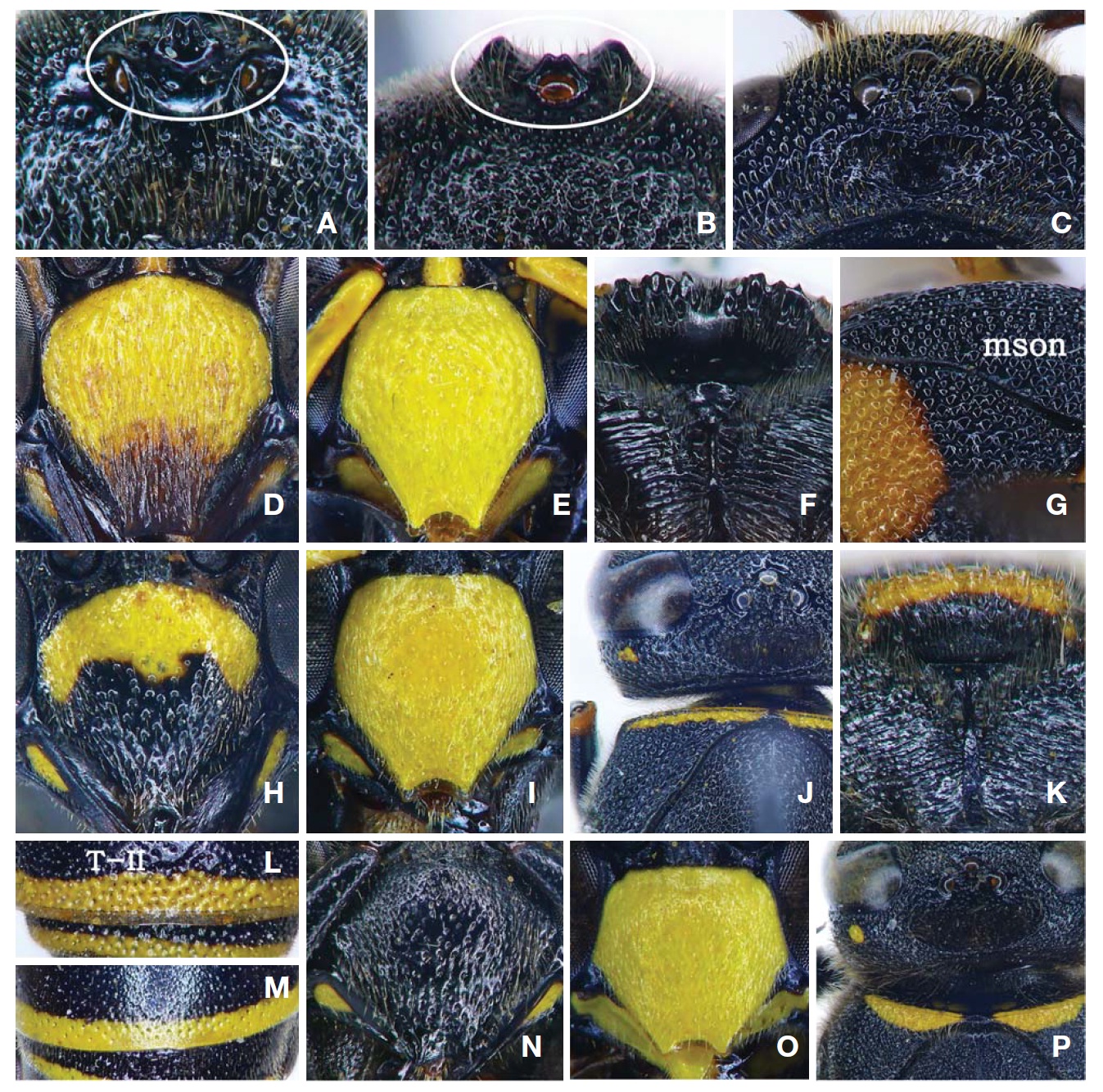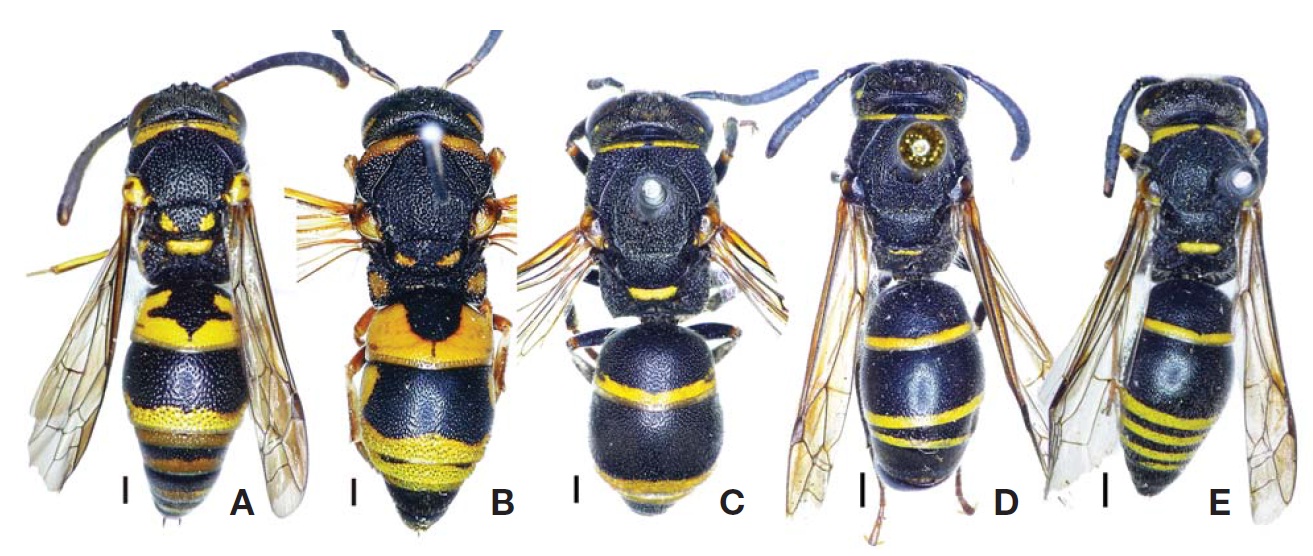



The members of the genus
As a result, four species in the Korean Peninsula were identified, including
Specimens which were housed at the Hanseo University (Seosan-si, Chungcheongnam-do, Korea) and Sk. Yamane Collection (Kagoshima Univ., Japan) were mainly used in this study. North Korean material was loaned from the Hungarian Natural History Museum (HNHM). All the examined specimens other than those from the Korean Peninsula were also listed herein.
Terminology principally follows that of Bohart and Stange (1965), Carpenter and Cumming (1985) and Yamane (1990). All measurements were taken as the maximal length of body parts being measured under an image analyzer. Body length was measured from the anterior margin of the head to the posterior margin of the metasomal tergum II. Lateral lobes were excluded from the measurement of the clypeal width.
As to previously described species and subspecies, the reference to the original publication is provided, with depository of types in parenthesis following. The synonymic list includes the references treating the forms that occur in the Korean Peninsula.
Order Hymenoptera
Family Vespidae
Subfamily Eumeninae
Genus Euodynerus Dalla Torre, 1904
Diagnosis. Out of the eumenine genera having sessile metasoma (metasomal segment I almost as broad as segment II, and tergum I much broader than long), this genus can be easily separated by the combination of the following external features. Cephalic fovea medium-sized to large, shallow and transverse, posteriorly bordered by a weak carina (sometimes obsolete) and with a pair of pits usually spaced by the diameter of posterior ocellus. Pretegula carina and furrow well developed. Epicnemial carina usually well developed; pleural and epipleural sutures deep and wide with sharp dense keels on the bottom. Posterior margin of horizontal face of metanotum carinate and dentate; posterior face of metanotum almost precipitous. Propodeum without shelf; submedian carina ending near each posterolateral area of metanotum (the superior median portion of propodeum without carina), where the carina usually strongly developed into an acute projection. Metasomal tergum I without basal transverse carina, with an apical lamella at the same plane as tergal disk. Sternum II somewhat truncated behind its basal sulcus. Prestigma of forewing short, less than one-third as long as stigma. Terminal segment of male antenna bent backward.
Key to the Korean species of the genus Euodynerus Dalla Torre
1. Ocellar region polished with distinct three tubercles: one of them, apically bifid, situated just behind anterior ocellus and the others close to inner margins of posterior ocelli (circular region of Fig. 1A, B). Upper frons just below ocellar region distinctly and densely bipunctate, with both large punctures and medium-sized punctures (Fig. 1B). Cephalic fovea comparatively small, its breadth almost as long as the distance between posterior ocelli (Fig. 1A). In both sexes, yellow apical band on tergum I being dilated in lateral parts and black median part characteristically arrow head-shaped (Fig. 2A). ???????
- Ocellar region without any tubercle (Fig. 1C). Upper frons strongly reticulate or densely punctate mainly with large punctures, not distinctly bipunctate, at most interspace among punctures with sparse small punctures. Cephalic fovea comparatively larger, its breadth longer than the distance between posterior ocelli (Fig. 1C, J, O). In both sexes, the apical band on tergum I simple or dilated laterally (Fig. 2A-D); if being dilated in lateral parts, black median part not arrow head-shape (Fig. 2B). ?????????????????????????????????? 2
2. Clypeus longer than broad in both sexes; female clypeus with dense longitudinal carinae and its apical margin almost truncated (Fig. 1D, E). In both sexes, below twothird of posterior vertical face of metanotum impunctate and shining; posterior margin of horizontal face of metanotum with large irregular denticles; carina on propodeal posterior face strong (Fig. 1F). Mesonotum almost bare at most partially with sparse short hairs (Fig. 1G). Cephalic fovea medially smooth and somewhat polished (Fig. 1C). Body maculation extensive: apical band on tergum I being dilated laterally (Fig. 2B). ???????????????????????????????????????????????????????????????????????
- Clypeus as long as broad, or broader than long in both sexes; female clypeus with dense punctures (not carinate) and its apical margin shallowly to moderately emarginated (Fig. 1H, I, M, O). In both sexes, posterior vertical face of metanotum below shagreened, not shining; posterior margin of horizontal face of metanotum with fine and somewhat regular denticles (Fig. 1K). Mesonotum with dense erect hairs (Fig. 1J, P). Cephalic fovea somewhat coarse with dense various size punctures. Body maculation reduced: apical band on tergum I narrow and simple without distinct lateral dilation (Fig. 2C-E). ??????????????????????????????? 3
3. Head and mesosoma with short erect dense hairs of uniform length (Fig. 1J). Clypeus almost as long as broad (Fig. 1H, I). Cephalic fovea with both large punctures in its marginal portion, which are almost as large as nearby punctures, and microscopic punctures. Metasomal tergum II with a short but distinct apical lamella; punctures on the tergum strong and large (Fig. 1L). Sternum II medially with a longitudinal groove in subbasal part. ???????????????????????????????????????????????????
- Head and mesosoma with long disheveled hairs of vari-
able length (Fig. 1P). Clypeus broader than long (Fig. 1N, O). Cephalic fovea mainly with dense micropunctures on almost entire face. Metasomal tergum II without apical lamella; punctures on the tergum feeble and smaller (Fig. 1M). Sternum II medially without a distinct longitudinal groove in subbasal part, at most with an obscure impression. ??????????????
Euodynerus trilobus (Fabricius), 1787
Material examined. Korea: 1♀ , Isl. Jejudo, Hanrim, 8 Oct 1955, collector not stated; 1♂, Isl. Jejudo, 31 Aug 1957, Lee BJ; 1♂, Mt. Hanra, collection date and collector not stated. Japan: 10♀ ♀ and 36♂♂ (recorded in Yamane, 1990).
Distribution. Africa to China: Jiangsu, Zhejiang; Korea: Isl. Jejudo; Japan: Honshu, Shikoku, Kyushu; Taiwan.
Remarks. As shown in the key, this species is unique in having three tubercles in ocellar region. In Korea, this species is very rare and known just from Isl. Jejudo. There has been no find of additional specimens since 1958.
Euodynerus dantici violaceipennis Giordani Soika, 1973
Material examined. Korea: 47♂♂, 10♀♀, Gyeongsangnam- do: Mt. Gayasan, 5 Aug 1960, Kim CW; 1♂, Seoul: Ui-dong, 6 Jun 1961, Kwon YH; 1♀, Chungcheongnam-do: Hongseong, 19 Aug 1961, Park JS; 1♂, Jeollanam-do: Haenam, Mt. Duryunsan, 15 Aug 1972, Kim JI; 1♀, Gangwondo: Gangchon, 23 Jun 1974, Yang DH; 1♂, 2♀♀, Jeollanam- do, Seungju, Mt. Jogyesan, Seonamsa (temp.), 7 Aug 1976, Nam SH; 2♀♀, ditto. 8 Aug 1976, Kim CW; 1♀, Gyeongsangnam-do: Jungsan-ri, Mt. Jirisan, 30 Jul 1981, Han HY; 1♀, Seoul: Seocho-gu, Mt. Cheonggyesan, 6 Sep 1986, Kim KH; 1♀, ditto, 15 Aug 1991, Park MR; 1♀, Prov. South Pyeongyang: Lyong-ak san, 14 km W. of Pyeongyang, 30 Jul 1975 (specimen identified E. dantici brachytomus by Giordani Soika, 1982); 1♀, Gyeonggi-do: Mt. Myeongjisan, 23 Aug 1978, Han HY; 1♂, Yangpyeong-gun, Yeonsu-ri, 31 Aug 1980, Jang KS; 1♀, Mt. Chukryeongsan, Sudong, 28 Sep 1980, Jang KS; 1♀, ditto, 11 Jul 1983, Hong HS; 1♀, Gwangju-gun, Eommi-ri, 18 Sep 1981, Kim YR; 1♀, Gyeongsangbuk- do: Gyeongsan-si, Yeungnam Univ. campus, 17 Aug 1987, Choi WH; 1♀, Gyeongsangnam-do: Milyanggun, Chodong-myeon, Sanwol-ri, Deoksansa, 8 Aug 1987, collector not stated; 1♀, Gyeonggi-do: Ganghwa-gun, Isl. Buleumdo, 18 Aug 1987, Yu HJ; 1♀, Gangwon-do: Myeongju- gun, Seongsan, 13 Aug 1989, Kim D; 1♂, Gyeongsangnamdo: Haman-gun, Baekjin-myeon, Baekunam, 11 Jun 1990, collector not stated; 1♀, Gyeonggi-do: Namyangjugun, 25 Aug 1991, Yun GY; 2♂♂, Isl. Ganghwado, Hamheodongcheon, 7 Aug 1992, Kim JK; 1♀, 2♂♂, Chungcheongnam- do: Taean-gun, Nam-myeon, Dalsan-ri, 2 Aug 1992, Kim JK; 5♂♂, Gyeongsangnam-do: Changwon-gun, Gusan-myeon, Gubok-ri, 10 Aug 1992, Kim JK. Japan: 10♀♀ and 7♂♂ (recorded in Yamane, 1990).
Distribution. China: Jianxi (Canton, Soochow); Russian Far East; Korea; Japan: Honshu, Awaji-shima, Kyushu.
Remarks. This species is polytypic, comprising more than ten subspecies in the Palearctic region (van der Vecht and Fischer, 1972; Giordani Soika, 1986), and three subspecies has been known to distribute in the Far East, i.e., subsp.
Euodynerus nipanicus nipanicus (Schulthess), 1908
?
?
Material examined. Russia: 1♂, Peishla, nr. Ussurisk Reserve (150 m alt.), S. Primorie, 22 Jul 1990, Yamane S; 2♂♂, 17 km S.W. of Krounovka (130-150 m alt.) nr. Chinese border, S. Primorie, 29 Jul 1990, Yamane S. Korea: 1♂, Seoul, 21 Jul 1971, Kim JI; 1♂, Prov. South Pyeongyang: Dae-Sangsan, 12 km of Pyeongyang, 21 May 1970 (specimen identified
Distribution. China (Lee, 1985; Giordani Soika, 1986): Heilongjian, Jilin, Liaoning, Hebei, Shandong (“ Tai-shan” ), Zhejiang (Hanchaw, Ning-Po, Chusan), Jiangsu (Nan king, Shanghai), Guangdong, Guangxi, Yunnan, Sichuan (Yachow, Suifu, Tsianfou); Eastern Russia: Magadan, Sakhalin, Amur, Primorie; the Korean Peninsula; Japan: Hokkaido, Honshu, Iwai-jima, Isl. Oki (Nishino-shima), Shikoku, Kyushu, Isl. Tsushima, Isl. Amakusa, Akune-oshima, Isl. Osumi, Isl. Ogasawara (introduced? ).
Remarks. Based on the European voucher specimens (♀, Steiermark, Rocksec, NE Mureck, 46°43′ :15°48′, 20 Jul 1998, Gusenleitner J; ♀, Steiermark, Wardprecht, S Stranden, 46°47′:15°48′ , 19 Jul 1991, J. Gusenleitner; ♂, Steiermark, Oberrau, 46°43′:15°54′, 10 Jul 1991, Gusenleitner J; ♂, ditto, 15 Aug 1993, ditto),
The original description of
Euodynerus quadrifasciatus atripes Giordani Soika, 1976
Yamane, 1990: 47 (in key), 59; Kim and Yoon, 1996: 202.
Material examined. Russia: 4♀♀, 1♂, 40 km E. of Ussurisk, Ussurisk Reserve (140-160 m alt.), S. Primorie, 14 Jul 1990, Yamane S; 1♂, 17 km S.W. of Krounovka (130-150 m alt.) nr. Chinese border, S. Primorie, 29 Jul 1990, Yamane S. Korea: 1♀, Prov. Ryang-gang: Plateau Chann-Pay, Samziyeon, 1,500 m (holotype); 1♀, Seoul: Mt. Cheonggyesan, 26 Jun 1985, Song KI; 1♀, Mt. Bukhansan, 18 May 1986, SJH; 1♀, 1♂, Gyeonggi-do: Mt. Suraksan, 14 May 1978, Jeong HJ, Kang SJ; 1♂, Maseok, 26 May 1989, Cho HS; 2♂♂, Pocheon, Mt. Jugeumsan, 31 May 1992, Kim JK; 1♂, Gangwon-do: Naeseolak, Yongdae-ri, 28 May 1983, Kim JI; 1♀, Pyeongchang, Gapyeong, 5 Jun 1985, Lee OK; 1♀, Pyeongchang, Doam, Yongam-ri, 9 Jun 1985, Kim YS; 1♀, Chungcheongnam-do: Cheongyang-gun, Mt. Chilgapsan, 26 May 1990, Park EH; 1♀, Gangwon-do: Gapyeong-gun, Mt. Cheonggyesan, 11 Jun 1991, Kim DJ; 1♂, Jeollabuk-do: Geumreung-gun, Eopo-myeon, Yongdae-ri, 28 May 1992, Kim JK; 1♂, Gangwon-do: Wonju-si, Socho-myeon, Kyohak 2-ri, 6 Jun 1996, Yin HS; 1♀, Seoul: Mt. Guryongsan, 27 May 1998, Park HC. Japan: 1♀ and 2♂♂ (recorded in Yamane, 1990).
Redescription. Female. Body length 8.5-10.0 mm. Cephalic fovea broadly transverse (its breadth 1.5× as long as the distance between posterior ocelli), with dense micropunctures, thus distinctly demarcated from surrounding area with macropunctures, with a slightly deeper area in its medial portion. Clypeus more or less distinctly broader than long, approximately 1.2 times as broad as long. Epicnemial carina very weak, and almost obscure in upper half of ventral mesepisternum. Body sculpture coarse, and body punctures shallow and medium in size.
Following parts/markings yellow (Fig. 2D): a transverse lower frontal spot, a triangular marking at madibular base, a pair of spots on temples, a narrow anterior band on pronotal dorsum (interrupted medially), horizontal face and upper marginal portion of vertical face of metanotum, narrow and somewhat regular apical bands on terga I-V (all the bands almost identical in width), and posterior lateral parts of sternum II. Lower faces of all tarsi reddish black.
Males much as in females except for following differences. Body length 6.0-7.5 mm. Clypeus only slightly broader than long. In addition to the markings mentioned for the female, the following parts yellowish (Fig. 2E): entire surface of clypeus, labrum and mandible except for margins, antennal scape below, both anterior and posterior spots on tegula, a short apical band on tergum V, a line on inner face of fore femur in its half, inner face of mid femur, and outer faces of all tibiae and tarsi. Inner faces of all tarsi reddish yellow.
Distribution. Far Eastern Russia: Primorie; the Korean Peninsula; Japan: C. and N. Honshu.

